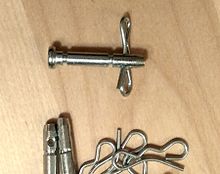Shear pin

Shear bolt with cotter pin for a hand-held snow blower
A shear pins , shear or short shear pin is a machine element .
Shear bolts are used as easily replaceable overload protection whenever sudden blockages or overloads of machine parts cannot be ruled out and these would lead to considerable damage to the machine or uncontrollable behavior. In the field of mechanics, they perform a similar function to a fuse in an electrical circuit.
Shear pins have a shape similar to a standardized pin , but wear in the center a circumferential notch . The bolt is sheared along this notch in the event of an overload due to the resulting shear stresses .
Shear bolts can be used, for example:
- small and large agricultural equipment, e.g. B. the mower drive in lawn mowers
- Propeller attachment to boats and outboard motors
- the load limitation for mechanically driven cable winches with worm gear . Here shear bolts at the connection between the drive shaft and the gearbox are used to interrupt the power transmission when the maximum load is exceeded. Due to the self-locking property of the worm gear, the load then stops.
- Machine tools in the event that the tool z. B. collides with the workpiece in rapid traverse .
- Shear bolts are also sometimes used in the suspension of aircraft engines. If major damage occurs to the engine with strong vibrations, these bolts give way. The engine is thrown off in a controlled manner without causing major damage to the wing. On the El-Al flight in 1862 , the failure of a shear bolt led to disaster.
literature
- Association of German ironworkers, Association of German iron and steel industrialists (ed.): Steel and iron. Journal for the German Ironworks, Volume 82, 1962.
- Hans-Günther Rachner: steel link chains and chain drives. Springer Verlag, Berlin Heidelberg 1962.
- P. Gerlach (Eds.), M. Coenen, E. Lupberger, A. Schmidt, G. Unold, Fr. Wicke, C. Zietemann: Freytag's auxiliary book for mechanical engineering for mechanical engineers and for teaching at technical schools. Eighth edition, published by Julius Springer, Berlin 1930.
Web links
- Complete catalog (accessed June 4, 2020)
- Use of threaded rods as shear bolts in reinforced concrete assembly construction (accessed on June 4, 2020)
- Use of shear bolts in reinforced concrete assembly construction (accessed June 4, 2020)
- Load-bearing behavior and dimensioning of fastenings on the edge of the building component with additional reinforcement under shear loads at right angles to the edge (accessed on June 4, 2020)
- Shear force dowel (accessed June 4, 2020)